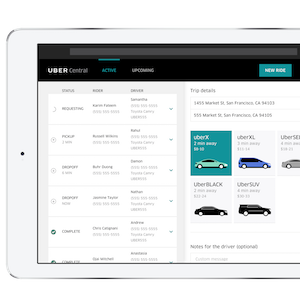 Uber continues to see healthcare as a major area for growth, according to Lindsay Elin, head of Federal and Community Affairs at Uber. At a panel at the Connected Health Conference in Washington, DC today, Elin spoke about a partnership with health system MedStar (whose director of consumer health initiatives, Pete Celano, also attended), a new team of employees dedicated to health, and the expansion of several programs including working with Circulation, a startup that recently spun out of Boston Children’s Hospital.
Uber continues to see healthcare as a major area for growth, according to Lindsay Elin, head of Federal and Community Affairs at Uber. At a panel at the Connected Health Conference in Washington, DC today, Elin spoke about a partnership with health system MedStar (whose director of consumer health initiatives, Pete Celano, also attended), a new team of employees dedicated to health, and the expansion of several programs including working with Circulation, a startup that recently spun out of Boston Children’s Hospital.
“Today, 75 percent of the US lives in a county where they have access to Uber,” Elin said. "Uber is really expanding transportation options available to those who might otherwise be underserved or not have access to a range of transportation options. Specific constituencies are certainly being served by Uber such as the disability community, the elderly, and low income communities. We firmly believe with partnerships with healthcare providers, senior centers, and transit agencies that we can do even more and reach more people.”
Elin talked about three Uber projects that help serve underserved populations, not counting Circulation or some efforts in the pilot stage. UberCentral is what MedStar is using in place of taxi vouchers to get patients to and from appointments.
“We were the first healthcare system to partner with Uber,” Celano said. “We moved our taxi voucher spend over to UberX. And Uber was good to create a better way to order those rides, it’s called UberCentral. With UberX, the cost is much lower, we’re able to hail an UberX inside that hour. We fill a slot that would otherwise go empty. And finally we find much better support in terms of, [for example] helping a chemo patient up the steps of their house after their infusion.”
In Washington DC, MedStar is lucky in that Uber has wheelchair-accessible vehicles in its fleet. Elin says the company is experimenting WAVs in 13 pilots across the country but hasn’t quite figured out how to leverage them in a scalable way. UberCentral has a memo field that lets the hospital give drivers a heads up about special needs.
“In terms of workaday stuff, oxygen tanks or walkers, the beauty of UberCentral is we can message the driver. Drivers can help if they know about it,” Celano said. “The most common memo field is ‘Please help the patient up the steps of their home because they’re sick’.”
Celano also said that, even having to pay for rides for low income patients, it’s a money-saving proposition for the hospital, because the Uber will pretty much always cost less than the money lost to a missed appointment.
Elin mentioned two other Uber programs that can help hospital patients, seniors, and people with disabilities: UberAssist and UberFamily. UberAssist consists of giving certain drivers special training in helping passengers with special needs. UberFamily simply allows someone to request a ride for a family member.
“I cannot tell you how many people are using those to get their elderly loved ones not just to their medical appointments but to their weekly bridge game,” Elin said.
She said that since the MedStar launch, the company had been approached by a number of health systems, so they have now hired a small team to do that outreach. Meanwhile, the pilots with Circulation at Boston Children’s Hospital and elsewhere have been well enough received that the company plans to expand to additional hospitals in Massachusetts, Pennsylvania, and Delaware in the next year.

















